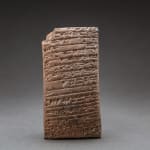Sumerian Cuneiform Tablet, 2027 BCE
Clay
2.24 x 4.3
LSO.30
Clay Tablet, with 28 Lines of Sumerian Cuneiform writin This is an administrative document from the period of the Third Dynasty of Ur, dated to the second year of the...
Clay Tablet, with 28 Lines of Sumerian Cuneiform writin This is an administrative document from the period of the Third Dynasty of Ur, dated to the second year of the last king, Ibbi-Sin, c. 2207 BC. It is a balanced account of barley assigned to gardeners. The background is that barley was the chief agricultural crop of Sumer, not wheat because wheat is less tolerant of the salt which abounded in the soil of Sumer due to evaporation of water under summer heat. Barley provided both food and drink: bread and beer. The land had to be irrigated to provide a good area for crops, and the irrigation was done communally, under the government. Much of the irrigated land was owned by government or temples, which were in fact practically under government supervision. So the state could produce vast crops of barley each year, which had to be stored and kept under close supervision to enable surpluses to be sold off and to prevent deficits occurring before the following harvest. This is one document with such a background, probably from the management of a temple estate. Barley was measured by bulk, a sila being about .85 of a litre, a gur being the next high unit (= 300 sila). Translation: 219 gur, 270 sila, total available. From it:
10 gur, 120 sila, rations for serfs when the earth was dredged from the Mamma-Sharrat canal.
48 gur 10 sila: receipt through Mr Ilum-rab 57 gur 20 sila: granary at Tiniktum, collective receipts from the gardener through Mr En’u’ 115 gur 150 sila: the disbursemen [……] + 3 gur, 55 sila, granary at Tiniktum: document of Mr Ilum-asu, scrib 31 gur, granary of Anzaga 40 gur, 75 sila, granary at Pappas, document of Ilum-rabi, chief…
104 gur, 270 sila: the granar Total: 219 gur, 270 sil Previous disbursement at the granar Accounts of the barley rations for gardener Year that the high priestess of Inanna of Uruk was chosen by divinatio *** The gardeners referred to would be working on the date-palm groves. The figures in the first section add up correctly to the total. In the second case the first figure is incompletely preserved, but if it were “44 gur” then the gur are correct but the sila are too few. The tablet lacks one corner, but is otherwise fairly well preserved.
10 gur, 120 sila, rations for serfs when the earth was dredged from the Mamma-Sharrat canal.
48 gur 10 sila: receipt through Mr Ilum-rab 57 gur 20 sila: granary at Tiniktum, collective receipts from the gardener through Mr En’u’ 115 gur 150 sila: the disbursemen [……] + 3 gur, 55 sila, granary at Tiniktum: document of Mr Ilum-asu, scrib 31 gur, granary of Anzaga 40 gur, 75 sila, granary at Pappas, document of Ilum-rabi, chief…
104 gur, 270 sila: the granar Total: 219 gur, 270 sil Previous disbursement at the granar Accounts of the barley rations for gardener Year that the high priestess of Inanna of Uruk was chosen by divinatio *** The gardeners referred to would be working on the date-palm groves. The figures in the first section add up correctly to the total. In the second case the first figure is incompletely preserved, but if it were “44 gur” then the gur are correct but the sila are too few. The tablet lacks one corner, but is otherwise fairly well preserved.



